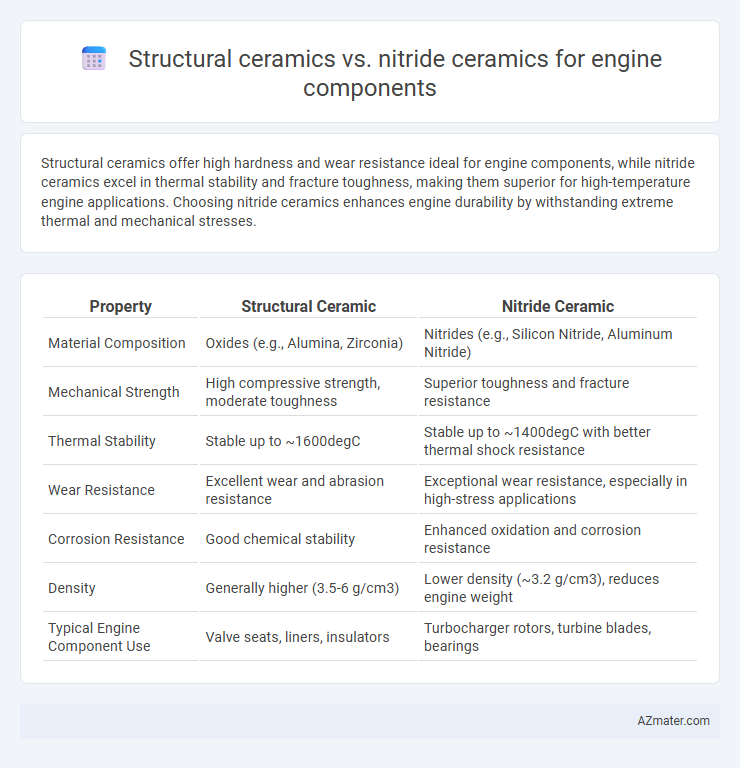Structural ceramics offer high hardness and wear resistance ideal for engine components, while nitride ceramics excel in thermal stability and fracture toughness, making them superior for high-temperature engine applications. Choosing nitride ceramics enhances engine durability by withstanding extreme thermal and mechanical stresses.
Table of Comparison
| Property | Structural Ceramic | Nitride Ceramic |
|---|---|---|
| Material Composition | Oxides (e.g., Alumina, Zirconia) | Nitrides (e.g., Silicon Nitride, Aluminum Nitride) |
| Mechanical Strength | High compressive strength, moderate toughness | Superior toughness and fracture resistance |
| Thermal Stability | Stable up to ~1600degC | Stable up to ~1400degC with better thermal shock resistance |
| Wear Resistance | Excellent wear and abrasion resistance | Exceptional wear resistance, especially in high-stress applications |
| Corrosion Resistance | Good chemical stability | Enhanced oxidation and corrosion resistance |
| Density | Generally higher (3.5-6 g/cm3) | Lower density (~3.2 g/cm3), reduces engine weight |
| Typical Engine Component Use | Valve seats, liners, insulators | Turbocharger rotors, turbine blades, bearings |
Introduction to Ceramic Materials in Engine Components
Structural ceramics and nitride ceramics are widely utilized in engine components due to their exceptional hardness, high-temperature stability, and wear resistance. Structural ceramics such as alumina and zirconia offer excellent mechanical strength and corrosion resistance, making them ideal for pistons, valves, and cylinder liners. Nitride ceramics, including silicon nitride and boron nitride, provide superior thermal shock resistance and fracture toughness, enhancing the durability and performance of engine parts under extreme operating conditions.
Overview of Structural Ceramics
Structural ceramics for engine components exhibit high hardness, excellent wear resistance, and superior thermal stability, making them ideal for high-stress and high-temperature applications. Compared to nitride ceramics like silicon nitride, traditional structural ceramics such as alumina and zirconia provide enhanced compressive strength but generally lower toughness. Engine components benefit from nitride ceramics' better fracture toughness and thermal shock resistance, enabling improved durability and performance under cyclic thermal loading.
Understanding Nitride Ceramics
Nitride ceramics, such as silicon nitride (Si3N4), exhibit exceptional fracture toughness, thermal shock resistance, and wear resistance compared to traditional structural ceramics like alumina or zirconia, making them ideal for demanding engine components. Their low density and high strength at elevated temperatures enable improved fuel efficiency and extended engine life by reducing weight and enhancing durability. Understanding nitride ceramics' superior mechanical properties and chemical stability under harsh operating conditions highlights their increasing application in high-performance engine parts.
Key Material Properties Comparison
Structural ceramics, such as alumina and zirconia, offer excellent hardness, high compressive strength, and exceptional wear resistance, making them suitable for engine components subject to mechanical stress and abrasive conditions. Nitride ceramics, including silicon nitride and boron nitride, provide superior fracture toughness, thermal shock resistance, and lower density, enhancing engine performance by reducing component weight and improving durability under rapid temperature changes. The balance between high hardness in structural ceramics and toughness in nitride ceramics determines the optimal choice based on specific engine operational demands.
Performance in High-Temperature Environments
Structural ceramics such as alumina and silicon carbide excel in engine components by offering exceptional hardness, wear resistance, and thermal stability at temperatures up to 1200degC. Nitride ceramics, including silicon nitride, outperform them in high-temperature environments with superior thermal shock resistance, fracture toughness, and consistent mechanical strength above 1400degC. Their enhanced oxidation resistance and lower thermal expansion make nitride ceramics ideal for critical engine parts exposed to extreme thermal cycling and stress.
Wear and Corrosion Resistance
Structural ceramics such as alumina and zirconia exhibit exceptional wear resistance due to their high hardness and fracture toughness, making them suitable for engine components exposed to abrasive conditions. Nitride ceramics like silicon nitride combine superior wear resistance with excellent corrosion resistance, particularly against high-temperature oxidizing environments, enhancing durability in engine parts. Silicon nitride's thermal shock resistance and chemical stability outperform many traditional structural ceramics, ensuring longer service life under cyclic thermal and mechanical stresses.
Mechanical Strength and Durability
Structural ceramics like alumina and zirconia exhibit high compressive strength and excellent wear resistance, making them suitable for engine components subjected to mechanical stress. Nitride ceramics, such as silicon nitride, offer superior fracture toughness and thermal shock resistance, enhancing durability under cyclic loading and high-temperature conditions. The combination of high mechanical strength and thermal stability in nitride ceramics often results in longer service life and improved reliability for critical engine parts.
Manufacturing and Processing Differences
Structural ceramics like alumina and zirconia offer high hardness and wear resistance, benefiting from cost-effective manufacturing techniques such as injection molding and sintering. Nitride ceramics, including silicon nitride and boron nitride, require advanced processing methods like hot isostatic pressing and chemical vapor deposition to achieve superior toughness and thermal shock resistance. These manufacturing differences impact engine component performance by balancing precision, durability, and thermal reliability in high-stress environments.
Cost Considerations and Scalability
Structural ceramics for engine components typically offer lower raw material costs and established large-scale manufacturing processes compared to nitride ceramics, making them more cost-effective for high-volume production. Nitride ceramics, such as silicon nitride, provide superior mechanical properties and thermal shock resistance but involve higher material and processing expenses, impacting overall affordability. Scalability favors structural ceramics due to mature supply chains and fabrication techniques, whereas nitride ceramics face challenges in cost-efficient mass production despite their performance advantages.
Application Suitability and Use Cases
Structural ceramics like alumina and silicon carbide exhibit excellent wear resistance and high-temperature strength, making them ideal for engine components exposed to mechanical stress and thermal cycling. Nitride ceramics, such as silicon nitride, offer superior fracture toughness and thermal shock resistance, enhancing durability in high-speed engine parts like turbochargers and valves. Engine components requiring a balance of toughness, thermal stability, and chemical inertness frequently utilize nitride ceramics, while structural ceramics remain preferred for components prioritizing hardness and wear resistance.

Infographic: Structural ceramic vs Nitride ceramic for Engine component
 azmater.com
azmater.com